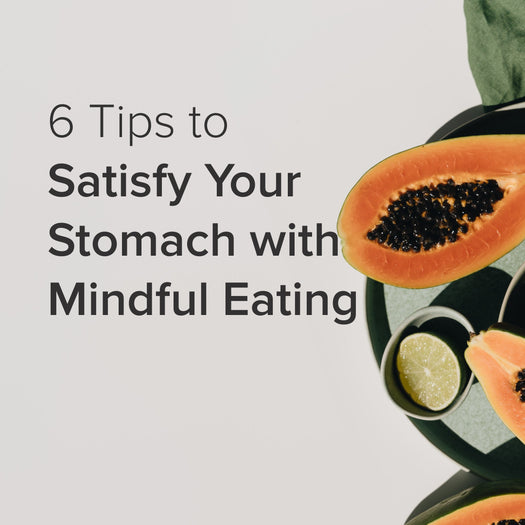6 Tips to Satisfy Your Stomach with Mindful Eating

Mindful eating helps reconnect with the experience of food. When we eat mindfully, we empower ourselves to make healthy choices that truly nourish our bodies.
When’s the last time you thought about the journey the food you’re munching on took, to land on your plate? How often do you take time to explore your food’s flavor and texture, savoring the fullness of a single bite?

If you’re like most of us, odds are you haven’t done this in the past few years, if ever. Life is more hectic than ever nowadays, and eating on the go or munching during work is pretty normalized. We go out to eat as a fun social outing with friends. We eat out of habit and use food to distract or comfort us when we feel sad or stressed…
The U.S. Department of Agriculture reports the average adult spends about two and a half hours a day eating and drinking. However, of the 153.5 minutes, we spend consuming food and drink, over half that time we’re doing something else too [1].
This way of consuming food is often called mindless eating. And unfortunately, it usually doesn’t lead to a great relationship with food, nor does it help our long-term health.
What is Mindful Eating?
Mindful eating is a way of engaging with our meals that focuses on strengthening awareness and appreciation of our food and bodies. It’s rooted in the foundations of mindfulness, which aim to cultivate non-judgmental awareness of our thoughts, feelings, body, and environment. Mindfulness skills can help us notice what’s happening inside us in the present moment. This can lend us greater freedom and choice in our behaviors and habits.
The same principles of mindfulness can be applied to mindful eating. Many of us have lost connection with our bodies’ hunger signals. Mindful eating provides the opportunity to reconnect with our bodies and re-engage with the experience of eating. Mindful eating empowers us with awareness so we can make eating an intentional act rather than an automatic one.
Mindful Eating vs. Mindless Eating
We’ve talked about the philosophies behind mindful eating, but what does it look like in practice? To best understand mindful eating, it’s helpful to explore what mindful eating is not, AKA mindless eating.
Mindless eating can look like:
- Emotional eating (e.g., eating when you’re stressed, sad, bored, lonely)
- Eating while engaged in another activity
- Eating when you’re not hungry or past the point of being full
- Making food choices based on emotional comfort, which isn’t always healthy
- Snacking throughout the day
- Inhaling your food without paying attention to how it makes you feel
On the flip side, mindful eating looks like:
- Eating only when you feel the signs of physical hunger (e.g., growling stomach, stomach aches, low energy)
- Listening to your body and stop eating when full
- Savoring the full experience of your food and how it makes you feel
- Not multitasking when eating
- Planning to eat at set times and places
- Considering the story and journey of your food
The Benefits of Mindful Eating
Part of what sets mindful eating apart as a practice for health and longevity is that it’s not a diet. It doesn’t involve any restrictions or “off-limits” foods. Instead, it’s all about moderation.
Mindful eating has been used to help:
- To explore and shift your relationship with food (e.g., why you eat, what triggers you to eat, what foods you eat and when)
- Learn to identify other sources of hunger (emotional eating versus true hunger)
- Feel full sooner while eating less food
- Become more connected to your body’s hunger and fullness signals, leading to more balanced and healthier eating
- Aid digestion by eating at a slower pace
- Make healthier food choices and build more nourishing habits
- Enjoy your food more by slowing down to appreciate its journey to you and the full experience of eating it
The Research Behind Mindful Eating
Eating mindfully doesn’t just help with shifting how you think and feel about food. Research has found that mindfulness is associated with a reduced calorie intake, fewer instances of impulsive eating, and healthy eating choices. Additionally, this research found that mindful eating was associated with a preference for healthy meals and snacks [2].
Mindful eating can also be a supportive tool for those who struggle with challenging eating habits. One study found that a mindfulness-based weight loss program led to increased mindfulness, and improved restraint around eating. It also led to significant reductions in weight, binge eating behavior, eating disinhibition, negative mood, depression, and physical symptoms [3].

6 Tips for Mindful Eating
Ready to restore and revitalize your connection to your food and body? Here are seven ways you can start to practice mindful eating.
1. Learn to Recognize Your Body’s Signals
Are you actually hungry or do you feel compelled to eat for other reasons? When you feel the familiar desire to grab something to munch on, explore what you’re feeling. Consider what true hunger feels like for you, and identify the difference between that feeling and other hunger cues.
2. Explore Why You Eat and When
What are your motivations and reasons for eating? Consider when you feel hunger cues and which situations prompt emotion or habit-based hunger cues versus true hunger. Do you eat when you feel stressed, or do you turn to mindless munching when you’re bored? What emotions make you want to eat?
3. Slow Down When You Eat
Did you know that it takes 20 minutes for your brain to send out signals of fullness? When we eat too fast, we don’t give our bodies and brains enough time to process what we’re eating. This can easily lead to accidental overeating and weight gain. When you eat slowly, you give your body time to catch up. To slow down, try putting your utensils down between bites or chew each bite of food between 20-40 times. Take deep breaths or drink water between bites. Consider the full flavor and texture of each bite, and how that experience changes as you chew.
4. Consider Your Food on a Deeper Level
Appreciate the full experience and journey of your food. Before you take your first bite, look at your food. What are all the ingredients that went into your meal? Trace the journey of each ingredient. First, it was planted or grown, then harvested and placed on a grocery store shelf, before being purchased by you. Consider all the people who played a part in creating this meal before you. This process can deepen your connection to your food and also cultivate greater gratitude and mindfulness surrounding our meals.
5. Cultivate an Environment for Healthy Food Choices
If you’re working remotely, consider how your space impacts mindful eating choices. Are comfort food options the easiest to see and grab in your house? Consider the foods you’re eating – do they actually make you feel good, or are they the easy and comforting options? Instead, organize your food so healthier options are the first thing you see, making it simpler and easier to prioritize foods that actually nourish your body.
6. Make Eating an Experience
Instead of eating at random times or on the go, make eating an experience. It can be easy when we’re isolated or working remotely to eat when we can or as we’re working. Sometimes, this may be unavoidable. When possible, put aside time solely for eating. Reserve time on your calendar just to eat, whether that’s ten minutes or a longer meal. When you eat, prioritize eating.
References:
